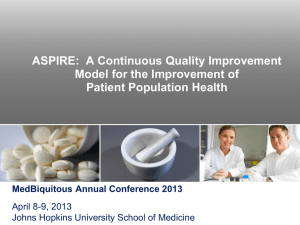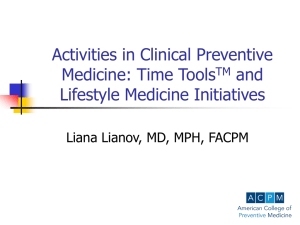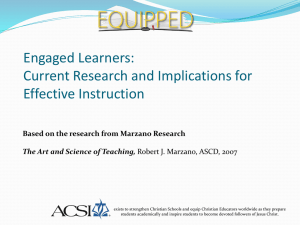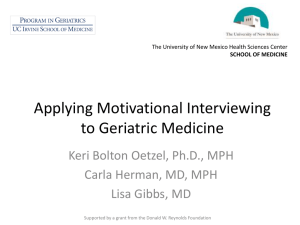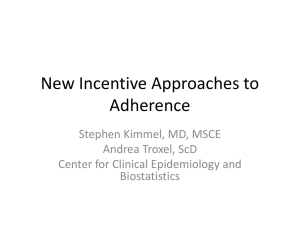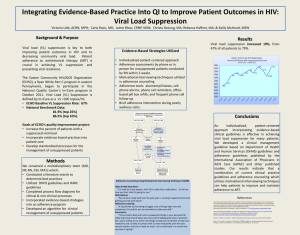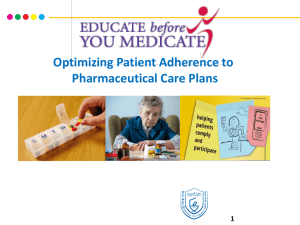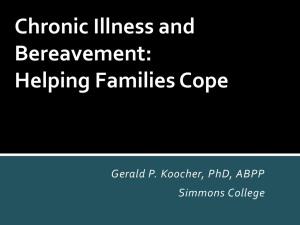Presenter Disclosure Information Valentin Fuster, M.D., Ph.D.
advertisement
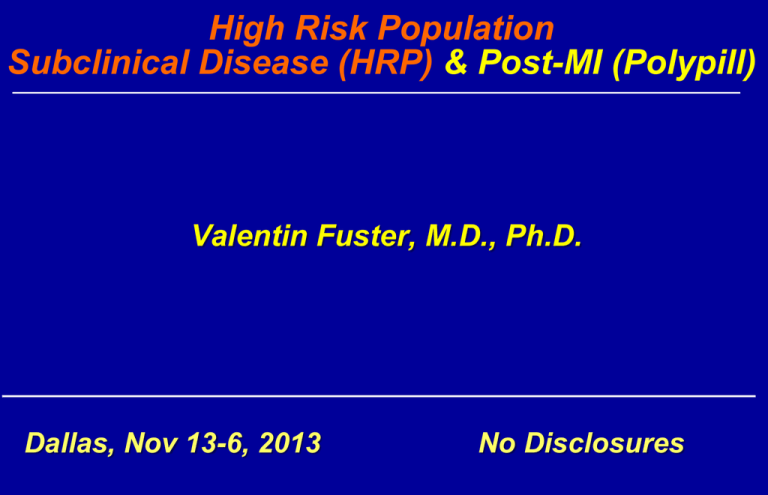
High Risk Population Subclinical Disease (HRP) & Post-MI (Polypill) Valentin Fuster, M.D., Ph.D. Dallas, Nov 13-6, 2013 No Disclosures High Risk Population Subclinical Disease (HRP) 1. Vulnerable Plaque – Invasive Approach ? A) Restricted Population with Complex Disease B) Mild Angiography, Significant IVUS & Pathology 2. Vulnerable Patient – Non-invasive Burden Approach A) Large Population with Silent Disease B) RF + Burden of Disease at 3D-US & CAC C) What is next ? 1. Vulnerable Plaque ? B) Mild at Angiography, Significant at IVUS & Pathology STABLE PLAQUE Angiogr., IVUS UNSTABLE PLAQUE Angiogr., IVUS, Pathology RUPTURED PLAQUE Pathology Modified from G Niccoli et. al. JACC Cardiovasc Img. 2013;6:1108 GW Stone, J Narula JACC: Cardiov. Imag. 2013:6;1124 A Arbab-Zadeh, M Nakano, R Virmani, V Fuster, et. al. Circ. 2012;125:1147 Vulnerable Plaque – Invasive Approach ? A) Restricted Population with Complex Disease D Butler. Nature. 2011;477:261 (UN. NCD). At Present R. Beaglehole et. al. Lancet 2008;372:1988 - > 30% Across, 2030 V Fuster, BB Kelly, R Vedanthan , Circulation. 2011;123:1671 High Risk Population Subclinical Disease (HRP) 1. Vulnerable Plaque – Invasive Approach ? A) Restricted Population with Complex Disease B) Mild Angiography, Significant IVUS & Pathology 2. Vulnerable Patient – Non-invasive Burden Approach A) Large Population with Silent Disease B) RF + Burden of Disease at 3D-US & CAC C) What is next ? High Risk Population Subclinical Disease (HRP) 1. Vulnerable Plaque – Invasive Approach ? A) Restricted Population with Complex Disease B) Mild Angiography, Significant IVUS & Pathology 2. Vulnerable Patient – Non-invasive Burden Approach A) Large Population with Silent Disease B) RF + Burden of Disease at 3D-US & CAC C) What is next ? 2. Vulnerable Patient – Non-invasive Burden A) Large Population & Silent Disease D Butler. Nature. 2011;477:261 (UN. NCD). At Present R. Beaglehole et. al. Lancet 2008;372:1988 - > 30% Across, 2030 V Fuster, BB Kelly, R Vedanthan , Circulation. 2011;123:1671 High Risk Population Subclinical Disease (HRP) 1. Vulnerable Plaque – Invasive Approach ? A) Restricted Population with Complex Disease B) Mild Angiography, Significant IVUS & Pathology 2. Vulnerable Patient – Non-invasive Burden Approach A) Large Population with Silent Disease B) RF + Burden of Disease at 3D-US & CAC C) What is next ? B). PESA & AWHS 40-54y, n= 8,000 , FU 0,3,6 y HRP > 55y, N=6000 FU 3y c). a). Predictive ? b). Economics ? Life Style & Imaging ? Pesa Systemic Score Omics (Framingham) Telomeres (S.blot, qPCR, Fresh) Carotid Plaque Burden, mm3 3D US - Manual Sweep 2D vs Transducer Focal structure into the arterial lumen of at least 0.5 mm or 50% of surrounding IMT value. 37% missed at Classical 2D CardioSCORE-R7-ApoA1, Apo B, B2M, CEA, CRP, Lp(a),Transferrin H Sillesen, P Muntendam, E Falk, V Fuster et.al JACC Imag. 2012;7:681. Calcification of the Coronary Arteries (CAC) 1. Cross Interaction Between Carotid Plaque Area & CAC IMT vs Focal: + Ilio-Femoral: +++ (n = 1480) (n = 1477) (n = 1479) (n = 1478) Carotid Plaque Area Quartiles U Baber, R Mehran, E Falk, V Fuster et al, 2013 2. PESA Systemic Score With Age And Gender (N=2578, Age 40-54yo, 35% Women) LJ Jimenez Borregueva, AI Fernandez Ortiz, V Fuster et. al. 2013 15.0 5.0 10.0 P-value<.0001 0.0 Cumulative Incidence, % 3a. Cumulative MACE by Framingham Score 0 365 2049 2445 1337 1786 2207 1229 Number at risk Low Risk Intermediate Risk High Risk 730 Analysis time, Days 1603 2023 1124 U Baber, R Mehran, E Falk, V Fuster et al, 2013 1095 555 737 402 10.0 5.0 P-value<.0001 0.0 Cumulative Incidence, % 3b. Cumulative MACE by 2D US Carotid Plaque 0 500 1000 Analysis time, Days No Plaque Tertile 2 Tertile 1 Tertile 3 U Baber, R Mehran, E Falk, V Fuster et al, 2013 15.0 5.0 10.0 P-value<.0001 0.0 Cumulative Incidence, % 3c. Cumulative MACE by Coronary Calcium Score 0 365 730 1095 Analysis time, Days CAC 0 CAC 100-400 CAC 0-100 CAC > 400 U Baber, R Mehran, E Falk, V Fuster et al, 2013 4a. Reclassification: INCORRECT, CORRECT Status at follow-up examination Coronary artery calcium Non-Case Predicted Framingham <3% 3%-6% >6% Case <3% 3%-6% >6% Predicted Framingham plus score Reclassified Net correctly reclassified (%) <3% 3%-6% >6% Increased risk Decreased risk 2240 588 47 103 1465 180 0 308 672 411 815 7.21 27 13 1 1 59 8 1 27 68 29 22 3.41 NRI 10.62 2D ultra sound Non-Case <3% 3%-6% >6% Case <3% 3%-6% >6% 2234 554 44 108 1480 172 1 327 683 436 770 5.96 27 12 1 58 1 29 31 20 5.37 1 7 69 NRI 11.33 4b. 2D-US Transducer + CAC Impact on Events (Intermediate FRS Group) U Baber, R Mehran, E Falk, V Fuster et al, 2013 High Risk Population Subclinical Disease (HRP) 1. Vulnerable Plaque – Invasive Approach ? A) Restricted Population with Complex Disease B) Mild Angiography, Significant IVUS & Pathology 2. Vulnerable Patient – Non-invasive Burden Approach A) Large Population with Silent Disease B) RF + Burden of Disease at 3D-US & CAC C) What is next ? C1). PESA & AWHS 40-54y, n= 8,000 , FU 0,3,6 y c).Life Style & Imaging ? Pesa Systemic Score e). Omics (Framingham) Telomeres (S.blot, qPCR, Fresh) HRP > 55y, N=7000 FU 3y a). Predictive ? b). Economics ? d). 5 More Yrs of Follow-Up C2). In-vivo, Diabetic Carotid - PET/MRI RR Moustafa, J Rudd et. al. Circ Cardiov. Imag. 2010;3:536 R Corti & V Fuster EHJ 2011 (April 19) JD Spence. Circ. 2013;127:739 Diffuse: Inflammatory / Lipid – Transcr. Doppler: M-emboli / Stroke C3). DBD & Traditional CV Risk Factors White Matter Lesion Volume and Cognitive Decline 1. V Novak, I Hajjar. Nat. Rev. Cardiol. 2010;7:686(HMS) 2. WB White et al.Circ 2011;124:2312 (Farmington,Yale) 3. AHA/ASA, Stroke 2011; 42:2672 - WHO - Dementia report 2012 4. JB Toledo et al. Brain July 10, 2013 5. C Russo et. al. Circ. 2013;128:1105 6. JR Kizer Circ 2013;128:1045 Ischemia affects 60 to 90% of patients with Alzheimer’s C4). Aging / Senescence Cellular Telomere & Telomerase 1 3 B Niemann et. al. JACC 2011; 57: 577. R Madonna, R De Caterina et. al EHJ 2011;32:1190 (Houston &Chieti, Italy) JC Kovacic, EG Nabel, V Fuster – Circ. 2011;123:1650 F Fyhrquist et al., Nat Rev Cardiol 2013; 10:274 – Healthy Lifestyle High Risk Population Subclinical Disease (HRP) & Post-MI (Polypill) Valentin Fuster, M.D., Ph.D. Dallas, Nov 13-6, 2013 No Disclosures Post-MI Polypll – 14 Comments Compliance / Adherence ( Rx ) & Economics 1. From Warnings to Promoting Health (2) 2. Low-Compliance vs Low-Adherence Definition, Quantification Worldwide (2) Clinical & Economic Impact of Low Adherence (2) The Causes or 7 Tenets of Low-Adherence (2) 3. Aiming at New Approaches The Adherence Estimator & Communication (2) Polypill & Adherence (2) A Community Call (2) 1) Major Documents on Global CV Health Promoting Cardiovascular Health in the Developing World; A Critical Challenge to Achieve Global Health. Ed. V Fuster and B Kelly. IOM of the Natl. Academies. Natl . Academies Press. Washington DC.2010. 2) Promoting Cardiovascular Health Worldwide 2012 Circ. 2011;123:1671 Scientific American, May 2014 (In Press) 2012 Post-MI Polypll – 14 Comments Compliance / Adherence ( Rx ) & Economics 1. From Warnings to Promoting Health (2) 2. Low-Compliance vs Low-Adherence Definition, Quantification Worldwide (2) Clinical & Economic Impact of Low Adherence (2) The Causes or 7 Tenets of Low-Adherence (2) 3. Aiming at New Approaches The Adherence Estimator & Communication (2) Polypill & Adherence (2) A Community Call (2) 1) Low-Compliance vs Low-Adherence Definition of Terms Compliance, Implies Passive Participation by The Patient (Life Style or Behavior, fluctuates). Adherence, Implies Active Participation by The Patient (Drugs, around the Clock) JM Castellano, R Copeland-Halperin, V Fuster, Global Health. 2013;8:263 L Osterberg, et. al. N Engl J Med. 2005;353:487. GN Varghese et. al. Drug Benefit Trends. 2008;20:17. National Council on Patient Information and Education. August 2007. 2). TRIALS TARGETS FOR RISK FACTOR CONTROL? Risk Factors - Proportion of Participants at Goal % – 1 year Hb A1C Meet Goals Base FU Trials LDL SBP DBP BARI-2D 75 56 70 52 14 20 COURAGE 51 55 55 59 12 19 FREEDOM 55 63 53 55 12 20 Freedom, Bari-2D, Courage Investigators, 2013 (In Press) PURE (S Yusuf et al.) Lancet 2011; Aug 28 - Poor Countries,7% !!! NHANES, AHA, NHLBI-JNC-7, NHLBI-NCEP P Muntner, V Fuster et al., AHJ 2011; 161: 719 Post-MI Polypll – 14 Comments Compliance / Adherence ( Rx ) & Economics 1. From Warnings to Promoting Health (2) 2. Low-Compliance vs Low-Adherence Definition, Quantification Worldwide (2) Clinical & Economic Impact of Low Adherence (2) The Causes or 7 Tenets of Low-Adherence (2) 3. Aiming at New Approaches The Adherence Estimator & Communication (2) Polypill & Adherence (2) A Community Call (2) 1) Projected Impact Of Polypill Use Among US Adults: Adherence and a 9 Year Event Rate – CAD & Stroke P Muntner, V Fuster, M Woodward et. al. Am Heart J. 2011;161:719 WHO. Adherence to Long-Term: evidence for Action, 2003 S Schuster et.al. Z Kardiol.1997;86:273- N Danchin et.al AHJ 2005;150:1147 2) The Cost of Low-Adherence in the US could be up to $300 Billion Each Year Medication Adherence May Lead to Lower Health Care Use and Costs Despite Increased Drug Spending New England Health Institute (NEHI) Research Brief: August 2009. MC Roebuck, et al. Health Aff. 2011;30(1):91 – MI-FREE AHA Nov 2011 Post-MI Polypll – 14 Comments Compliance / Adherence ( Rx ) & Economics 1. From Warnings to Promoting Health (2) 2. Low-Compliance vs Low-Adherence Definition, Quantification Worldwide (2) Clinical & Economic Impact of Low Adherence (2) The Causes or 7 Tenets of Low-Adherence (2) 3. Aiming at New Approaches The Adherence Estimator & Communication (2) Polypill & Adherence (2) A Community Call (2) 1) TENETS OF LOW ADHERENCE TO MEDICATIONS –“NO” 1. There is no such thing as a “non-adherent personality.”1 2. Patients - 83%- don’t tell physicians of their adherence. Physicians -74%- believe their patients are adherent.2 3. Adherence to prescription medications is largely not related to compliance or self-care and lifestyle.3 4. Effects of demographics - age, gender, education, & income - on adherence are small.4 1D Hevey. 2007 2KL Lapane Am J Manag Care 2007;13:613 - AL Goldberg, Soc Sci Med 1998;47:1873 3CA McHurney, Curr Med Res Opin 2009; 25:21 4MR DiMateo , Med Care 2004; 42:200 2) TENETS OF LOW ADHERENCE TO MEDICATIONS –“YES” 5. Patients want to know why the medication is prescribed, duration, possible side effects, what could happen if they don’t take it, and cost / affordability.5 6. Health care professionals should communicate less poorly on prescription medications - av. 49 sec, appropiate 3%.6 7. Taking medications is a decision-making process. Patients actively decide about their medications.7 5 CA McHurney, Cur Med Res Opin 2009;25:215 BJ Bailey, Progr Cardiov Nurs 1997; 12:23 - DK Ziegler, Arch Int Med 2001;161:706 6 DM Tarn, Patient Educ Cours 2008; 72:311, Arch Int Med 2006; 166:1855 7 SL William, Clin Interv Aging 2007; 25:453 Post-MI Polypll – 14 Comments Compliance / Adherence ( Rx ) & Economics 1. From Warnings to Promoting Health (2) 2. Low-Compliance vs Low-Adherence Definition, Quantification Worldwide (2) Clinical & Economic Impact of Low Adherence (2) The Causes or 7 Tenets of Low-Adherence (2) 3. Aiming at New Approaches The Adherence Estimator & Communication (2) Polypill & Adherence (2) A Community Call (2) 1).The Adherence Estimator For a New Prescription Concerns Commitment Cost CA McHorney. Curr Med Res Opin. 2009;25(1):215 Medication Adherence. Merck 2011. 2). Who Should Focus on These Patients and Promote Adherence Medication Adherence. Merck 2011. Post-MI Polypll – 14 Comments Compliance / Adherence ( Rx ) & Economics 1. From Warnings to Promoting Health (2) 2. Low-Compliance vs Low-Adherence Definition, Quantification Worldwide (2) Clinical & Economic Impact of Low Adherence (2) The Causes or 7 Tenets of Low-Adherence (2) 3. Aiming at New Approaches The Adherence Estimator & Communication (2) Polypill & Adherence (2) A Community Call (2) 1) CNIC-FERRER POLYPILL FOR 2ary PREVENTION. FOOD INTERACTION FOCUS 1 & 2 PHARMACOKINETIC INTERACTION WITH ASPIRIN BIO-EQUIVALENCE Argentina Brazil Paraguay Italy Spain ASA, Statin, ACE-Inhibitor PHARMACOKINETIC INTERACTION WITH SYMVASTATIN PHARMACODINAMIC INTERACTION WITH RAMIPRIL PHARMACODYNAMIC INTERACTION WITH SYMVASTATIN G Sanz, V Fuster Am. H J 2011;162:811 Semin.Thor.Cardiov.Surg 2011;23:24 Nature Rev Cardiology, 2013-In Press PHARMACOKINETIC INTERACTION WITH RAMIPRIL PHARMACODYNAMIC INTERACTION WITH ASPIRIN UMPIRE: High Risk, Two Polypills as FOCUS +Hctz or Atenolol vs Usual Care 86% Adherence vs 65%, Lower BP and LDL-C - Events NS --- JAMA 2013;310:918 2). POLYPILL STUDIES PUBLISHED OR IN COURSE Company Polypill Active components Red Heart Pill 1 Secondary Prevention ASA 75 mg, Lisinopril 10 mg, Simv. 20 mg, Aten. 50 mg Red Heart Pill 2 Primary Prevention ASA 75 mg, Lisinopril 10 mg, Simv. 20 mg, Hctz. 12.5 mg Cardia India Ramitorva Primary Prevention ASA 100 mg, Simv 20 mg,Ram 5mg Aten. 50 mg, Hctz. 12.5 mg Zyduscadila India Zycad Secondary Prevention Dr Reddy’s India UMPIRE Alborz Darou Iran ASA 75 mg, Atorv. 10 mg, Ram 5mg, Metoprolol 50 mg Polyran 1 ASA 81 mg, Atorv. 20 mg, Prim / Secon. Prevention? Enalapril 5mg, Hctz 25 mg Polyran 2 ASA 81 mg, Ator 20 mg, Prim / Secon. Prevention? Valsartan 40mg, Hctz 25 mg CNIC-FERRER Spain Trinomia Secondary prevention ASA 100 mg, Simv. 40 mg, Ram 2.5 / 5 / 10 mg Post-MI Polypll – 14 Comments Compliance / Adherence ( Rx ) & Economics 1. From Warnings to Promoting Health (2) 2. Low-Compliance vs Low-Adherence Definition, Quantification Worldwide (2) Clinical & Economic Impact of Low Adherence (2) The Causes or 7 Tenets of Low-Adherence (2) 3. Aiming at New Approaches The Adherence Estimator & Communication (2) Polypill & Adherence (2) A Community Call (2) 1) A Community Call Population Ageing & Cost The Lancet NCD Action (G Alleyne et. al.) Lancet. 2013;381:566 2) A Community Call The Message A. Compliance & Adherence are a Marathon, Not a Sprint B. Compliance & Adherence are the Key Drivers Enabling Patients to Achieve Their Treatment Goals World Health Organization 2003-2011 High Risk Population Subclinical Disease (HRP) & MI (Polypill) Valentin Fuster, M.D., Ph.D. Dallas, Nov 13-6, 2013 No Disclosures U Baber, R Mehran, V Fuster et al, 2013 High Risk Population Subclinical Disease (HRP) 1. Vulnerable Plaque – Invasive Approach ? A) Restricted Population with Complex Disease B) Mild Angiography, Significant IVUS & Pathology 2. Vulnerable Patient – Non-invasive Burden Approach A) Large Population with Silent Disease B) RF + Burden of Disease at 3D-US & CAC C) What is next ? C3). Cortical Atrophy (Alzheimer’s), White Matter Abnormalities & Lacunar Stroke JC Kovacic, V Fuster et. al. Circulation. 2011;123:1900 MA Lim et. al. Clin Geriatr Med. 2009;25:191. C4). The Hallmarks of Aging Aging is characterized by a progressive loss of physiological integrity, leading to impaired function and increased vulnerability to death. This deterioration is the primary risk factor for major human pathologies, including cancer, diabetes, cardiovascular disorders, and neurodegenerative diseases C Lopez-Otin et al., Cell 2013; 153:1194 Aging Is The Leading Risk Factor For Most Serious Chronic Disabilities T Tchkonia et. al. J Clin Invest. 2013;123:966 ENVIRONMENTAL OXIDATIVE STRESS Induction of telomere shortening Smoking Alcohol abuse Obesity Sedentary lifestyle Mental stress Inhibition of telomere shortening Healthy lifestyle F Fyhrquist et al., Nat Rev Cardiol 2013; 10:274 Promoting Health and Improving Survival Into Very Old Age The identification of strategies that can promote health and productivity into old age is one of the most important challenges facing public health. The current study’s findings, which suggest that modifiable social and behavioral factors increase survival among older people, but only when achieved early in life, preferably in childhood MM Glymour, TL Osypuk. BMJ 2012; 345:e6452 High Risk Population Subclinical Disease (HRP) 1. Vulnerable Plaque – Invasive Approach ? A) Restricted Population with Complex Disease B) Mild Angiography, Significant IVUS & Pathology 2. Vulnerable Patient – Non-invasive Burden Approach A) Large Population with Silent Disease B) RF + Burden of Disease at 3D-US & CAC C) What is next ? 1) UN Targets Top Killers – 4 Warnings D Butler. Nature. 2011;477:261 (UN. NCD). At Present R. Beaglehole et. al. Lancet 2008;372:1988 - > 30% Across, 2030 PREMISE (S Mendis et al) Bull. WHO 2005, 2007- LM-I, Pop / $ High V Fuster et al, Circ. 2011;123:1671 – H-I $ Rx / Prom. Health High Global Health. 2013;8:263 2a) Manhattan Project Quantificacion, Low-Adherence / Low-Compliance % Patients, Non-Adherence / Compliance 2b) Timing Adherence Decreases Adherence Decreases Signicantly Over the First 6 Months Significantly Over the First 6 Months (40%) A Critical Window of Opportunity PM Ho, BMC Cardiov. Discord. 2006;6:48 – Arch.Int.Med. 2006;166: 1842-MI RH Chapman, Arch Inter Med 2005;165:1147- BP & Lipid Rx AS Gadkari AS, et. al. Curr Med Res Opin. 2010;26(3):648 Data available from Merck, MI-FREE, AHA Nov 2011 2c) Quantificacion – Worldwide CHD / Stroke (N=153996) Non-Adherence to Medications CV drug category High-income (%) Upper-middle income (%) Lower-middle income (%) Low-income (%) Overall Antiplatelets 62.0 24.6 21.9 8.8 25.3 Beta blockers 40.0 25.4 10.2 9.7 17.4 ACE inhibitors ARBs 49.8 30.0 11.1 5.2 19.5 BP-lowering agents 73.8 48.4 37.4 19.2 41.8 Statins 66.5 17.6 4.3 3.3 14.6 All decreasing trends from higher- to lower-income, p<0.0001 PURE (S Yusuf et al.) – Lancet 2011; Aug 28 1a) Low-Adherence isN a Major Inefficiency In Our Health Care System WHO.Adherence Adherence to long-term therapies: evidence for action. 2003. WHO. to Long-Term: evidence for Action, 2003 Coletet. Arch Intern 1990;150(4):841. NNCol al. al. Arch Intern Med.Med. 1990;150:841 – MI-FREE, AHA N 2011 Dl Hershman et al Cancer Res Treat. 2011;126:529 DL Hershman etBreast al. Breast Cancer Res Treat. 2011;126(2):529. DDl Hershman et al. Breast Cancer Res Treat. 2001;126:52 1b) Patient’s Lack Of Adherence To Medication German MITRA Registry (MI, 6067) N=6067 S Schuster et al. Z Kardiol. 1997;86:273 French Registry (MI, 2320) N=2320 N Danchin et al AHJ 2005;150:1147 1) The FOCUS project: study 1 (N=4000) Study 2 Study 1 Economy and Health system characteristics: • GNI • Health care accesibility • Out-of pocket expenditure • Treatment accesibility • Treatment affordability • Prices of foods Patient’s characteristics: • Demographics • Psycosocial factors • Healths status • Clinical variables • Blood sample PEP: Adherence test (Morisky-Green) 1)The FOCUS Project: Study 2 Design (N=1340) Randomization 2nd visit 1st visit 1month Final visit 6-9 months 3rd visit 4 month 3 drugs separately Study 1 Polypill Clinical status Medication Blood pressure Blood sample Adverse effects Adherence test Pill counting PEP: Adherence test Pill counting SEP: Blood pressure Lipid profile Adverse effects
